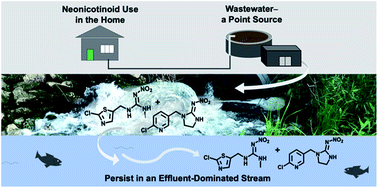Emerging investigator series: municipal wastewater as a year-round point source of neonicotinoid insecticides that persist in an effluent-dominated stream†
Abstract
Neonicotinoids in aquatic systems have been predominantly associated with agriculture, but some are increasingly being linked to municipal wastewater. Thus, the aim of this work was to understand the municipal wastewater contribution to neonicotinoids in a representative, characterized effluent-dominated temperate-region stream. Our approach was to quantify the spatiotemporal concentrations of imidacloprid, clothianidin, thiamethoxam, and transformation product imidacloprid urea: 0.1 km upstream, the municipal wastewater effluent, and 0.1 and 5.1 km downstream from the wastewater outfall (collected twice-monthly for one year under baseflow conditions). Quantified results demonstrated that wastewater effluent was a point-source of imidacloprid (consistently) and clothianidin (episodically), where chronic invertebrate exposure benchmarks were exceeded for imidacloprid (36/52 samples; 3/52 > acute exposure benchmark) and clothianidin (8/52 samples). Neonicotinoids persisted downstream where mass loads were not significantly different than those in the effluent. The combined analysis of neonicotinoid effluent concentrations, instream seasonality, and registered uses in Iowa all indicate imidacloprid, and seasonally clothianidin, were driven by wastewater effluent, whereas thiamethoxam and imidacloprid urea were primarily from upstream non-point sources (or potential in-stream transformation for imidacloprid urea). This is the first study to quantify neonicotinoid persistence in an effluent-dominated stream throughout the year—implicating wastewater effluent as a point-source for imidacloprid (year-round) and clothianidin (seasonal). These findings suggest possible overlooked neonicotinoid indoor human exposure routes with subsequent implications for instream ecotoxicological exposure.

- This article is part of the themed collections: Environmental Science: Processes & Impacts Recent HOT Articles and Emerging Investigator Series


 Please wait while we load your content...
Please wait while we load your content...